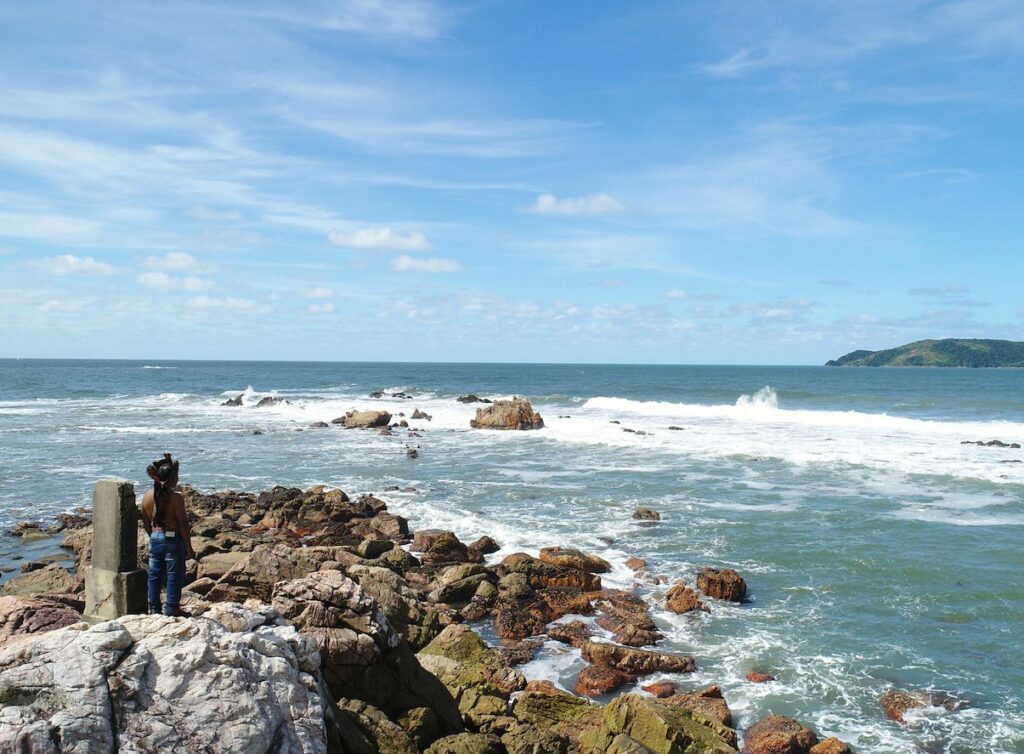Weltkulturen Museum, Frankfurt a.M., Germany
12 Oct 2017 - 26 Aug 2018

Rigo 23, United World – Scar of Tordesilhas, 2017. Performance, Brazil.
The Weltkulturen Museum presents contemporary interventions and works fusing the political and lyrical by the internationally renowned artists Ayrson Heráclito and Rigo 23.
The exhibition is the culmination of the museum’s many years of activities and research investigating the Afro- Brazilian and indigenous aspects of Brazil’s art and culture. It provides a new impetus in present perceptions of transatlantic art processes between Africa, Europe and America. This is especially evident in the artists’ encounters with objects from the museum’s South America and Africa collections. Their selection of objects, which is also on display, offers a fascinating insight into their own concerns and interests.
In large-scale installations, video works, photographs, sculptures and performances, both artists address and explore the power of historical events from the era of slavery and colonial rule – a power once emanating from Europe. Even now these events affect the lives of the descendants of Afro-American slaves in the diaspora as well as indigenous Guaraní in South America’s conurbations. This transatlantic, transtemporal ‘betweenness’ forces them into a life in transit.
Using participative methods, Rigo 23 realises art projects with the Guaraní in Brazil, which reflect the Guaraní’s creativity and spirituality, and have a strong political message. These are works testifying to how ‘marginalised peoples’ always were and still are actors with their own agency.
Ayrson Heráclito connects his art with the aesthetics of urban Afro- Brazilian culture and religion, which he reads as expressing a form of resistance, self-assertion and preservation of the culture of the slaves. Both artists highlight how art and culture empower survival in transit. With their own individual focuses, Ayrson Heráclito and Rigo 23 explore issues raised by the marginalisation of others temporally and spatially. Their works are dedicated to historical sites testifying to hegemonic memories, and inequalities.
Bioraphies
The Brazilian artist, scientist and curator Ayrson Heráclito (born in Macaubas, Bahia, Brazil, in 1968) is professor for Visual Arts at the Universidade do Recôncavo da Bahia in Cachoeira, Brazil. He holds a Doctor degree in Communication and Semiotics from the Pontifícia Universidade Católica de Sao Paulo (2016). His works transit between installation, performance, photography and the audiovisual, and frequently deal with elements of African-Brazilian culture and its connections with Africa, slavery and the diaspora in America. His artistic work is to be understood as a postcolonial criticism of slavery and racism. Ayrson´s works are based on his own research about natural materials and substances, such dende-oil, sugar, meat, sperm, blood and fish, which he describes as the ‘cultural body’ of the Afro-Brazilians. Centre of his art is often the human body. In 2017 he participates in the 57th Venice Biennial at the invitation of curator general Christine Macel, presenting a video- and photo installation as well as in the exhibition “Axé Bahia: The power of art in an Afro-Brazilian metropolis” at the Fowler Museum at UCLA in Los Angeles. Following an invitation by Marina Abramovic, in March 2015 he held the big performance “A Transmutacao da Carne” in Sao Paulo.
Rigo 23 (born 1966 in Madeira, Portugal) lives and works in Los Angeles. He studied Art at the San Francisco Art Institute and Stanford University (California). Rigo 23 taught art at the San Francisco Art Institute and was part of the first generation of the art movement “San Francisco Mission School” during the early 1990s. Rigo´s abundant works include murals, paintings and big installations. Being a political artist he develops his projects in strong collaboration with the most diverse groups, such as the Black Panthers, representatives of the American Indian Movement, the Zapatista movement in Mexico, and Guaraní groups in Brazil among others. His installations like the Guaraní version of a nuclear submarine “Teko Mbarate – Struggle for Life” and the Zapatista installation “Autonomous InterGalactic Space Program” do not only look phantasmagorical, but deal with the realities of life, world views, and political demands of Indigenous peoples. They also reflect on intercultural relations in the globalised world and the transformation of materials and objects as well as attitudes and practices in art. Rigo´s criticism of the exploitative and often violent attitude of the ‘first world’ towards other, especially small scale societies often follows a poetic path, just like the one these societies have been following for a long time.
In September 2017 Rigo 23 will participate in the Folkestone Triennal in Folkestone (England) and in the group exhibition “Mundos Alternos: Art and Science Fiction in the Americas” at UC Riverside (California, USA, 2017).
Opening: Wednesday, 11th October, 7pm
The exhibition is supplemented by loans from the Museu Coleção Berardo (Lisbon), the Galeria Tapeçarias de Portalegre and from the private collections of both artists.
The exhibition idea and design were developed in a process of dialogue between the curators and ethnologists Dr. Mona Suhrbier (curator Americas, Weltkulturen Museum) and Dr. Jane de Hohenstein (Salvador da Bahia, Brazil) and the two artists.
A richly illustrated accompanying publication with essays and articles as well as interviews with Ayrson Heráclito and Rigo 23 will be published by Kerber Verlag in English and German.
€7 / reduced €3.50
Under 18s free admission!
Tues-Sun, 11am–6pm and Wed, 11am–8pm
Weltkulturen Museum, Schaumainkai 29, 60594 Frankfurt am Main